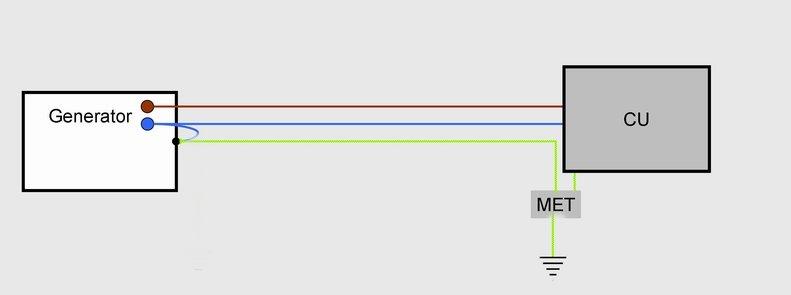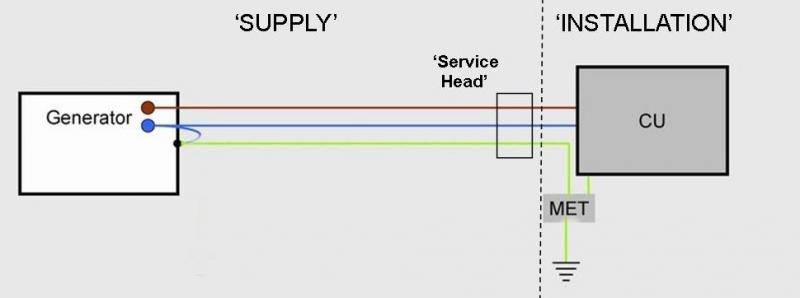I think this is probably still OK, but would appreciate any comments....
Something approaching 20 years ago, following a period of significant power cuts, I made some provision for generator back-up to maintain the CH system and a modicum of lighting during power cuts. Ironically, although it’s been tested fairly regularly, I don’t think it’s ever really had to be used in anger!
Rather than getting involved with a C/O switch, at the time I decided to go with a totally separate ‘installation’ for generator derived power. There is a (2kW, I think) portable genny located in an outhouse. Its output is plugged into a wall mounted (male) 16A ‘socket’ and thence via underground SWA to the house.
In the house, there is a mini DB/CU for the generator supply, with a 30mA RCD and a single 6A MCB. This ‘installation’ has a TT system of its own (the house is also TT), with its own earth electrode, and also has MPB. The one (6A protected radial) final circuit supplies a few lights scattered around the house (dedicated, totally separate from main house lighting), now CFLs, and a couple of sockets, all of which are clearly labelled. One of the sockets is designed to serve the CH system. The entire central heating electrical system (boiler, timers, pumps and motorised valves) is normally supplied via a single 13A plug (3A fused) plugged into a socket on one of the ordinary RFCs (rather than the more usual connection via a FCU). The ‘generator-supplied socket’ is adjacent to this one, so that the entire CH system can be unplugged from ‘the mains’ and plugged into it if necessary (without the need for a C/O switch).
This system appears to be in no way ‘broken’ (and probably even compliant with current regs), so I personally don’t see any need to have it ‘mended’ in any way. Any comments?
Kind Regards, John.
Something approaching 20 years ago, following a period of significant power cuts, I made some provision for generator back-up to maintain the CH system and a modicum of lighting during power cuts. Ironically, although it’s been tested fairly regularly, I don’t think it’s ever really had to be used in anger!
Rather than getting involved with a C/O switch, at the time I decided to go with a totally separate ‘installation’ for generator derived power. There is a (2kW, I think) portable genny located in an outhouse. Its output is plugged into a wall mounted (male) 16A ‘socket’ and thence via underground SWA to the house.
In the house, there is a mini DB/CU for the generator supply, with a 30mA RCD and a single 6A MCB. This ‘installation’ has a TT system of its own (the house is also TT), with its own earth electrode, and also has MPB. The one (6A protected radial) final circuit supplies a few lights scattered around the house (dedicated, totally separate from main house lighting), now CFLs, and a couple of sockets, all of which are clearly labelled. One of the sockets is designed to serve the CH system. The entire central heating electrical system (boiler, timers, pumps and motorised valves) is normally supplied via a single 13A plug (3A fused) plugged into a socket on one of the ordinary RFCs (rather than the more usual connection via a FCU). The ‘generator-supplied socket’ is adjacent to this one, so that the entire CH system can be unplugged from ‘the mains’ and plugged into it if necessary (without the need for a C/O switch).
This system appears to be in no way ‘broken’ (and probably even compliant with current regs), so I personally don’t see any need to have it ‘mended’ in any way. Any comments?
Kind Regards, John.






